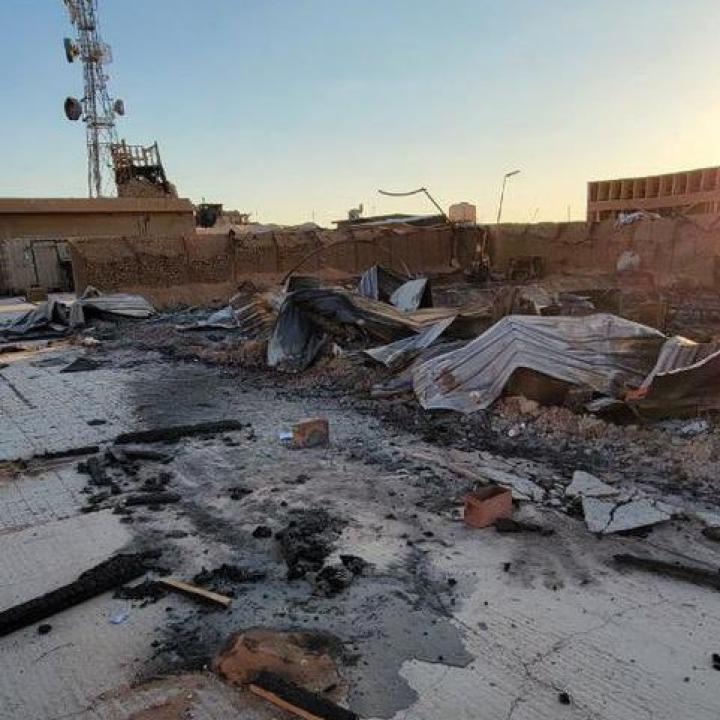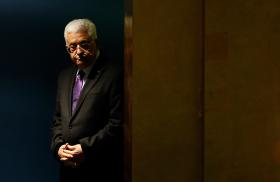
- Policy Analysis
- Fikra Forum
Raisi and the Continued Export of Revolution to Syria

The recent targeting of the al-Tanf base in Syria, where U.S. forces are stationed, highlights the ways in which the Iranian presence in Syria is becoming increasingly bold in line with the foreign policy goals of Iran’s new president.
Al-Tanf base, established in 2016 and an essential part of the war on ISIS, is a base where American and Coalition forces are stationed, training Jaysh Maghawir Al-Thawra. It is located at the Syrian, Jordanian, and Iraqi border triangle in the Homs province. On October 20, drones targeted the base, which American officials speaking to the Associated Press confirmed as five “Iranian drones” loaded with explosives.
The officials noted that while the drones had not taken off from Iranian airspace, Tehran had “facilitated” the execution of the air attack. Pro-Iranian media likewise indicated—without mentioning it by name—that the drone attack on al-Tanf was conducted by Iran and that it was in retaliation/response to the attack that occurred near Palmyra recently, which was attributed to Israel.
However, the targeting of al-Tanf base was likewise undoubtedly intended to deliver the clear message that Iran is a strong country able to take initiative, while also signaling the start of the era of Ibrahim Raisi and the end of the era of Rouhani. President Raisi has shown that he will not hesitate to act and respond, even towards U.S. targets.
While Iran’s foreign policy is subject to the Supreme Leader Ali Khamenei and his lobby regardless of who is in the presidential office, Raisi is likely to increase the depth and focus of Iran’s strategy of interference in regional countries as a member of Iran’s fundamentalist stream. Like Khamenei, Raisi seems committed to exporting the revolution on a doctrinal level and enhancing its regional role on the strategic level.
This is not to say that interference in foreign affairs did not occur when the reformist Rouhani occupied the presidency. Blatant Iranian interference in Syria, Lebanon, and Iraq was clear during this period, and indicated that Iran’s expansionist policy is an issue over which the president cannot diverge. Even so, Raisi’s personal alignment with Khamenei’s vision on this issue—along with an uptick in missile exchange between Iran and Israel inside Syria—suggests that the Iranian presence in the country will continue to entrench itself.
Raisi and the Revolutionary Hezbollah Faction:
The Revolutionary Hezbollah faction refers to an intellectual stream within Iran that adopts the steps and approach of the Supreme Leader, with the express doctrinal goal of exporting the revolution. The foundational approach of Velayat-e -Faqih, linking the religious authority of Iran’s marj’aia with that of the Iranian state, has shaped its approach since founding the Iranian Republic, leading most notably to the structure of Lebanese Hezbollah.
Raisi studied in the religious body El-Hawza el-’Elmiyah in the city of Mashhad, along with International Laws and judiciary in the city of Qum, both important indicators of Raisi’s doctrinal closeness to Khamenei. Raisi likewise supervised al-Atabah al-Raddwiyah, the religious institution affiliated with the Supreme Leader. Raisi seems to have impressed Khamenei, especially after the latter appointed him as the head of Iranian Judiciary to follow up with cases of corruption.
Raisi likewise has a bloody history in Iran as a member of the Execution Committee in 1988–which executed political prisoners during the Iraq-Iran war on the order of Khomeini, and during trials of the Green Movement in 2009. He has also been placed on the American blacklist due to his history of violations against human rights and his proximity to Khamenei. When he proposed his election agenda, Raisi stated that his government will be popular and based on the principles of the Islamic Revolution and Khomeini's approach.
Raisi and the Syrian file:
Raisi’s choice of government officials also suggests the government’s close consistency with Khamenei’s approach. For example, the new Minister of Intelligence is Esmail Khatib, who has a religious background and occupied different intelligence positions. This includes in the security sector of al-Atabah al-Raddwiyah, which Raisi himself ran.
More to the point of Iranian foreign policy, Raisi notably selected Hussein Amir-Abdollahian as the foreign minister to succeed Mohammad Javad Zarif, with the new Foreign Minister having the backing and acceptance of Khamenei. On his second official visit to Damascus as Foreign Minister, Abdollahian stated that Tehran and Damascus have achieved joint field procedures and victory in fighting terrorism. This statement is consistent with the fundamentalist’s orientations to war and military conflicts, especially in the past years. Abdollahian emphasized that Iran will continue to support the Assad regime and that Tehran and Damascus will continue to cooperate in numerous fields.
While Zarif has always been far from the fundamentalist movement and has faced internal criticisms, mainly over what is known as the issue of his audio leaks, the new Foreign Minister Abdollahian is attempting to fully identify with Khamenei’s political attitudes by demonstrating his support for the so-called "axis of resistance", which includes Hezbollah in Lebanon, the Syrian regime, Iraqi factions, and the Palestinian resistance.
Therefore, we see that Raisi's new government is not only conservative, but is to a large extent Khamenei-ist, especially with regard to exporting "political Shiism" and "the revolution".
Raisi's government is very coherent in terms of arranging its foreign priorities within the framework of political Shiism and influencing the political files in neighboring countries. In the case of Syria, Iran stresses the necessity of undermining the Sunni Islamic movements’ control there, as these movements pose a potential threat to Iranian national security. The Iranian strategy in Syria is to maintain an entrenched existence, sustain chaos and not reach solutions.
On receiving Hammouda Sabbagh—the chief of the Syrian Representatives Council—in Tehran, Raisi stated that the Syrian people are resistant and steadfast, adding also that the Assad regime is a revolutionary government. He also emphasized that the Syrian People and government overcame Hebrew and Western terrorism. Raisi added that expelling foreign forces from Syria as soon as possible is a must, even while legitimizing the Iranian presence in Syria.
Iran fears changes in the structure of the Assad regime, as it considers Assad's regime necessary for its continued presence in Syria. On the other hand, if stability is achieved in Syria, it will threaten Iranian militias’ leverage. Stability could damage the Iranian militias, especially as it seeks to adjust the military situation of the Assad regime.
The constant Iranian presence in Syria is consistent with Israel’s security plan which is based on striking IRGC and Lebanese Hezbollah targets on the Syrian territories, which Israel calls a “rat’s trap.” Israel has dealt severe strikes to Iran in Syria. This is enhanced as Iran deals with the Syrian file as a strategic one. Iran provides significant support for the Assad regime because Syria has become the battlefield of the Israeli-Iranian conflict.
As the foreign strategy of the Iranian Islamist Republic is subjected to the Supreme Leader, the existence of an extremist president who is close to the leader means that there will be increased consistency in Iran’s hard-line agenda. This will lead to easedimplementation of Iran’s regional policies, and will allow the country’s leaders to overcome the types of disputes that occurred between the government and the IRGC during Rouhani’s period.
Iran’s Focus on “Useful Syria”
When considering Iran’s strategy in Syria, it is clear that Iran seeks to entrench its presence not only on the military level, but also on economic, doctrinal, and political levels. Iran opening its consulate in May 2021 in Aleppo is just one indicator of Tehran’s intentions to serve as a cultural influence in the Syria that Assad is attempting to rebuild. The point is reinforced by Iran’s attempts to change the doctrinal nature into an Iranian-influenced Shia ideology in Aleppo or Damascus, and also in a number of areas where Iran is active, including places like Deir Ezzor where the vast majority is Sunni Arab. Iran works to open Hussainiyats and religious centers (Hawzat), recruit young men in militias, and spread their doctrines.
Early in the war, Assad defined his focus as recapturing what he called “useful Syria.” Iran also focuses on these areas, which extend from Damascus to al-Qalamoun, Homs, Daraa, and Hama down to Tartus, as well as Latakia and the border with Turkey in the northeast.
The Iranian strategy in Syria will not change unless the Supreme Leader reconsiders it, which seems unlikely. Especially with Raisi at the helm, it seems that the Hezbollah model will increasingly become the primary goal in Syria, regardless of American sanctions or Israeli pressure.
It is clear that Iran’s role in Syria—like the Assad regime—is increasingly entrenched in the country. Therefore, just as Iran’s continued role in Syria is part of the problem in the country, establishing a coherent strategy on Iran’s presence in Syria must be part of the solution. There are still windows of opportunity; in the heavily Sunni Deir Ezzor, non-military aspects of Iranian entrenchment are struggling to materialize, as Deir Ezzor is a cohesive, tribal society—despite its political divisionism. Were the Iranian military presence to leave this region, it would have little influence left. For other areas of Syria, however, this may not be the case. And the longer that the Iranian presence has time to entrench itself, the more likely that its goal of creating a Syrian Hezbollah model will materialize.


